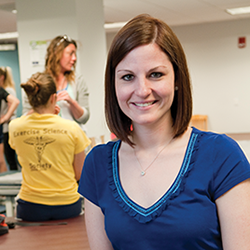GW’s Health Sciences Programs Prepare to Launch PT Neurologic Residency Program
When Elizabeth Ruckert graduated from Ithaca College with her Doctor of Physical Therapy (DPT) degree in 2006, she immediately accepted a job at a rehabilitation hospital in New Jersey, where she joined the traumatic brain injury rehab team. After just six months at the hospital, she began to question her decision. “I was feeling like there was so much I didn’t know, and I was realizing how hard it was to have structured, dedicated mentorship in this fast-paced health care environment,” she says. That’s when she began investigating physical therapy residency programs.

There were only two neurologic residency programs in the country at the time, and Ruckert chose to apply to the one at the University of Southern California (USC). She was accepted and spent the next year at Rancho Los Amigos National Rehabilitation Center, USC’s partner facility, where her foundational knowledge of neurologic practice and her clinical skills were further developed and refined through expert mentorship. The residency program also involved teaching in USC’s DPT program and conducting research in the school’s Neuroplasticity and Imaging Laboratory. “Each component of the residency program helped me attain a greater understanding of what comprises expert physical therapy practice. These experiences set the foundation for my path toward a future career in academia,” Ruckert says.
Ruckert, DPT, PT, NCS, GCS, now assistant professor in the Physical Therapy (PT) Program at GW’s School of Medicine and Health Sciences (SMHS), still cherishes her residency experience. So much so, in fact, that she is working with leadership in the Physical Therapy Department to develop a neurologic residency program here at SMHS in collaboration with the MedStar National Rehabilitation Network.
In accordance with the American Physical Therapy Association’s (APTA’s) strict credentialing requirements, a one-year pilot of the residency program will commence in August 2013. “Our mission is to develop neurologic specialist practitioners who demonstrate advanced clinical reasoning, assessment, and intervention skills for individuals with neurologic disorders across practice settings,” Ruckert says. The program will offer “very focused experiences and mentorship in neurologic physical therapy practice,” much like the experience offered in SMHS’s orthopedic residency program, which has existed in partnership with Johns Hopkins University since 2012.
Joyce Maring, Ed.D., DPT program director and associate professor at SMHS, notes that the field of physical therapy, like health care in general, is becoming more complex. “In order to provide the best-quality services, you really need practitioners and leaders who have advanced qualifications to be able to address the needs of a particular population,” Maring says.
Neurologic physical therapy focuses on the evaluation and treatment of individuals who have movement problems as a result of disease or injury of the nervous system. “We’re movement dysfunction specialists,” Ruckert says. “The goal is to maximize someone’s return to function, to life roles.”
The challenging curriculum requires residents to immerse themselves in different components of neurologic specialty practice. The program has four primary focus areas: clinical practice, teaching, research, and didactic education. The residents — ideally there will be two during the pilot year — will be responsible for treating patients for 20 hours per week. The first four months will be spent on acute care, the second four months on acute rehabilitation, and the final four months on outpatient rehabilitation.
They will also have a clinician mentorship, which Ruckert calls the hallmark of the residency program. “It’s focused time with a neurologic rehab specialist,” she says. “It gives the resident the opportunity to ask any questions they might have and engage in higher-level discussion related to clinical decision making, problem solving, and reflection.”
In addition to getting exposure to the entire health care continuum, the residents in the program will also have teaching opportunities within SMHS’s DPT program. Ruckert stresses the importance of including a teaching component in the model because “teaching requires synthesis of information at a much higher level. That’s very important to the development of a specialist’s understanding.”
Ruckert has a palpable enthusiasm for expanding postgraduate education opportunities for new PT. “These programs are so important to the development of our new clinicians,” she says. “I’m impassioned about finding ways to let other people have the same opportunities that I feel so privileged to have had.”
Related Content



